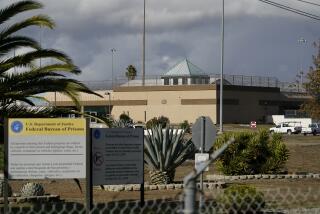California not following recommendation on parole agent caseloads
When the man who held Jaycee Dugard captive for 18 years was arrested, it became clear authorities had missed multiple opportunities to free her.
A state investigation placed that blame partly on the heavy workloads of the parole agents who were supposed to keep track of the kidnapper, a registered sex offender. And a blue-ribbon panel recommended that the number of cases agents supervise be cut dramatically.
Yet interviews and records show that years later, agents in California continue to watch over twice as many offenders as the task force deemed was safe — and many of their caseloads
exceed the state’s own limits.
The task force called for agents to supervise no more than 20 sex offenders at a time. California set its cap at 40 cases, and limited the number of high-risk parolees who could be part of an agent’s workload. Corrections department spokeswoman Deborah Hoffman said parole agents occasionally exceed the limits, usually during holidays or while covering for colleagues on vacation.
In written responses to questions from The Times, Hoffman said the department had given “considerable consideration” to the lighter workloads proposed by the task force but deemed them too costly.
According to parole agents and labor representatives, it is common for officers to work with as many as 40 parolees at a time, and that caseloads have grown as high as 50.
“That is criminal negligence … you cannot do that,” said Michael Taber, a retired state parole supervisor who was on the task force that recommended the 20-case cap. “When you do that, massive things are going to happen. People are going to die.”
Documents released to The Times show that the agents who monitored two Orange County parolees currently charged in connection with the deaths of four women were, at times, supervising more than 40 sex offenders. For weeks at a time, they also were responsible for overseeing more high-risk offenders than state rules allow.
Franc Cano and Steven Gordon — sex offenders arrested in April in connection with the deaths of Kianna Jackson, 20; Josephine Monique Vargas, 34; Martha Anaya, 28; and Jarrae Estepp, 21 — have pleaded not guilty.
Two of the women disappeared from the Santa Ana area in October, when Cano and Gordon were under state parole supervision. Only Cano remained on parole at the time police believe the other two victims were killed.
Corrections officials said one agent had as many as 42 sex offenders assigned to him while he was watching Cano and Gordon last August. Another agent who took over Cano’s supervision in September also had to watch as many as 42 parolees. But when the women are believed to have disappeared — in October, November and March — the caseloads for the agents overseeing the men fell below 40.
Records also show the agency exceeded policies on how many other parolees those agents could supervise alongside high-risk offenders.
In the two months before the first victim disappeared, the agent supervising Cano and Gordon went at least three weeks with 15 to 17 high-risk parolees on his watch, along with another 21 to 25 sex offenders. State rules should have limited him to six to 10 additional parolees.
The agent exceeded the allowed ratios again in October, as did three other agents assigned to supervise either Cano or Gordon between August and February.
Hoffman said the corrections department strives to adhere to its caseload policy but isn’t always able to because of sick workers, vacation and other circumstances.
Ondre Henry, president of the Parole Agents Assn. of California, said caseloads consistently exceed 40 parolees, and almost all agents have more than 20 cases. The workload, he said, hampers the ability to oversee sex offenders and fully investigate their whereabouts tracked on GPS devices.
“In the case of Gordon and Cano … yes, you can review the tracks. It’s a very useful tool. But unless you can actually do the investigative work ... it kind of defeats the purpose,” Henry said. “When you have caseload sizes that are so big, it’s hard to drill into those specific factors.”
The corrections department has not released complete files that would show how closely Cano and Gordon were monitored, citing the pending criminal case. But a provided list does show that from late 2009 until his arrest in 2014, Cano moved among five primary agents, and a sixth who provided coverage for six weeks. Gordon’s records show a similar pattern of being shuffled among agents.
Sex offenders’ supervision may shift for a variety for reasons, Hoffman said. But a veteran agent in Southern California said the caseload reassignment has been exacerbated by layoffs within the agency.
“It is very common, and it is … a big issue,” said the agent, who spoke on the condition of anonymity because he was not authorized by the department to discuss his work.
He described parolees being reassigned to as many as four agents in four months. Those who take on a new offender, the agent said, have little insight into the subtle shifts in behavior that may do more to signal trouble than their daily GPS tracks.
Although the corrections department did not adopt the 2010 task force recommendation to lower overall caseloads, it did follow one suggestion that created more work.
Agents who had been reviewing the GPS tracks of high-risk parolees daily and doing twice-monthly scans on those considered low-risk were ordered in 2012 to conduct mandatory daily reviews of all sex offenders.
Henry said the corrections department also is negotiating with the union over a proposal to raise the ceiling for supervising high-risk offenders from 20 cases per agent to 30.
paige.stjohn@latimes.compaloma.esquivel@latimes.com
More to Read
Start your day right
Sign up for Essential California for news, features and recommendations from the L.A. Times and beyond in your inbox six days a week.
You may occasionally receive promotional content from the Los Angeles Times.







